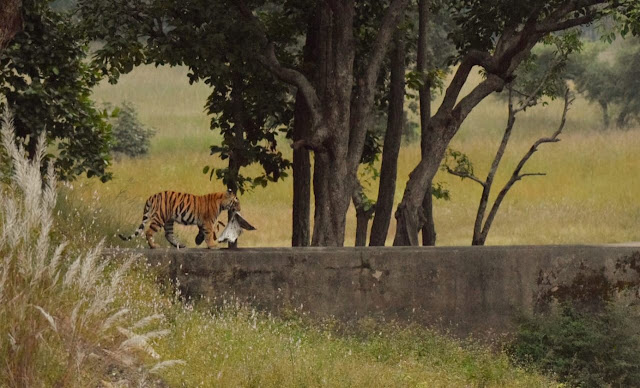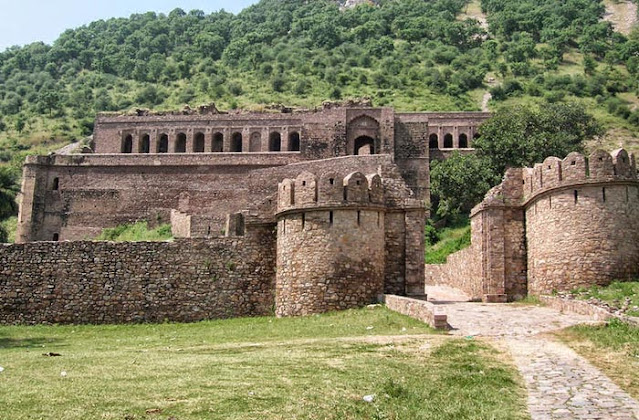How To Book A Wildlife And Tiger Safari In Bandhavgarh
All about Bandhavgarh National Park
Bandhavgarh has a rich and ancient history. Tenth century Bandhavgarh Fort sits majestically atop Bandhavgarh hill (unfortunately, the fort is not open to the public). “Bandhav” means brother in Sanskrit and “garh” means fort, so the name of the fort – and the park – is brother’s fort. The brother in question is Lakshman, younger brother of Ram, which means Bandhavgarh is associated with the Ramayana epic. This thickly forested region was part of the Maharaja of Rewa’s hunting grounds until 1968, when the family granted the land to the government to become a national park. In 1993, it was declared a tiger reserve under the Project Tiger initiative.
Bandhavgarh National park is divided into a core area, with three zones open to the public, and a buffer zone, totalling 1,598 square kilometres (including Panpatha Wildlife Sanctuary). The core area is 716 square kilometres, with the buffer zone adding another 820 square kilometres – but the area open to the public is only 105 square kilometres.
The zones open to the public are Tala, Magadhi, and Khitauli, and they each restrict the number of vehicles that can enter. Tala was the original zone, and it includes Bandhavgarh hill and the ancient fort. Three buffer zones, spread over Umaria and Katni district, were added to the Bandhavgarh to alleviate the pressure on the core zones and give more people an opportunity to visit the park. They are Dhamokhar, Panpatha and Johila.
As of this writing, summer 2019, Bandhavgarh has about 60 tigers, though locals say there could be as many as 65 to 75. This figure does not include cubs, only full-grown, adult tigers. Over the past winter, every female tiger in Bandhavgarh had cubs, so there was a lot of opportunity to see mother tigers with their cubs.
This is why Bandhavgarh is probably the best place to see a wild tiger in India — with so many tigers in such a small tiger reserve, your chances are better than just about anywhere else, plus the terrain helps, too. Spread over the Vindhyachal mountain range, in the Umaria and Katni districts of Madhya Pradesh, Bandhavgarh is comprised of a semi-dry deciduous forest, grasslands and sal forests, 32 hills, and some stunning dramatic scenery that includes soaring cliffs and rocky plateaus (especially in Tala zone, which has the most photogenic landscape and some say the highest tiger density, too).
The reserve experiences at least three seasons – summers, winters and monsoon – and it’s generally in well-preserved condition under the care of the Forest Department. (Though I have issue with the state of the toilets, which are deplorable …)
Bandhavgarh opens October 15 each year, and closes at the end of June. The park is closed from July 1 to October 14 to give the animals a break, and because of the monsoon season.
Get Your Customised Bandhavgarh Packages
How to Book A Wildlife And Bandhvagarh Safari
Bandhavgarh is a very popular national park and tiger reserve, and the number of vehicles that can enter each day is highly restricted. This means, it’s imperative to book your safari in advance (at least 90 days) to ensure that you get the dates you want.
You can enter the park either by jeep (Maruti Gypsy) or canter, an open bus-like vehicle. My preference would always be for the Gypsy of course, as it is small and agile, and you are with only 4 or 5 other people.
There are three core zones open to the public: Tala, Magadhi, and Khitauli, and you will be assigned a zone.
There are two safaris each day, morning and afternoon – and the park is closed every Wednesday afternoon. Timings for safaris in the core zone are:
- Morning: 6 am – 10 am or 6:30 – 10:30 am (depending on season)
- Afternoon: 2:30 pm – 5:30 pm or 3:00 – 6:00 pm or 4:00 – to 7 pm (depending on season)
You can book a safari permit through the MP Forest Department website but you will still need to book a guide and vehicle. If you are staying at a luxury lodge, they can book your safaris and provide you with a guide and vehicle.
Always remember to carry your passport with you on safari as it will be checked at the gate. You will be turned away if your passport does not match the booking name and details. Also remember to bring everything with you, as once you enter the park, you cannot leave and come back.
Best time to go on safari in Bandhavgarh
Bandhavgarh is worth visiting every day that it’s open, but there are different seasons and different reasons for going. Fall is pleasant, December and January are cold (it can drop to 2 C.) and April to June is very hot and can reach 45 C. – but it’s the best time to see tigers because they gather at water holes to cool off and drink.
Tala is said to be a good zone for tigers while Khitauli is said to be a good zone for birding. Late fall, when the migratory birds appear, is a great time for birding at Bandhavgarh.
What to wear on Tiger Safari
Never wear bright colours on wildlife safari. It disturbs the animals. Wear earthy tones like beige and khaki, and layers as it’s chilly in the morning and then warms up. A hat is essential and so is a buff, or scarf, to cover your nose and mouth on dusty drives. Wear sunscreen and bring sunglasses, plus binoculars, camera equipment, your passport and some rupee notes to tip the guides. I also recommend a water bottle, tissue, and hand sanitizer (plus wet wipes). Toilet conditions are not good at Bandhavgarh, I’m sorry to say, you are basically on your own as far as hygiene is concerned.
Getting to Bandhavgarh National Park
Like all the best tiger reserves, Bandhavgarh is in a remote location and it does take a bit of time and effort to get there. Of course, it’s absolutely worth it when you do. The nearest train stations are Umaria (45-minute drive) and Katni (two-and-a-half hour drive). The nearest airport is Jabalpur, a four or five-hour drive away. There are trains and flights from Delhi every day. If you are coming from Khajuraho, one of the most popular tourist attractions in Madhya Pradesh, I recommend driving. Though it’s a long drive, it’s the most direct way to get there.
Once you make the journey all the way to Bandhavgarh, you are within driving distance of Kanha National Park, another one of the best parks in India for seeing a tiger. And from Kanha, you can drive to Pench, and then from there to Satpura.

